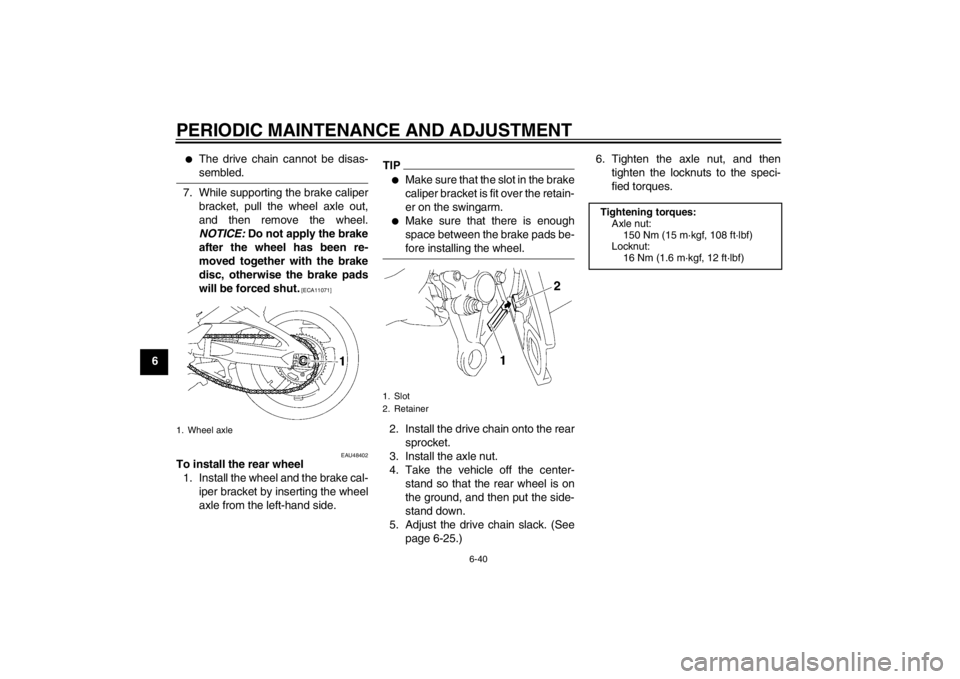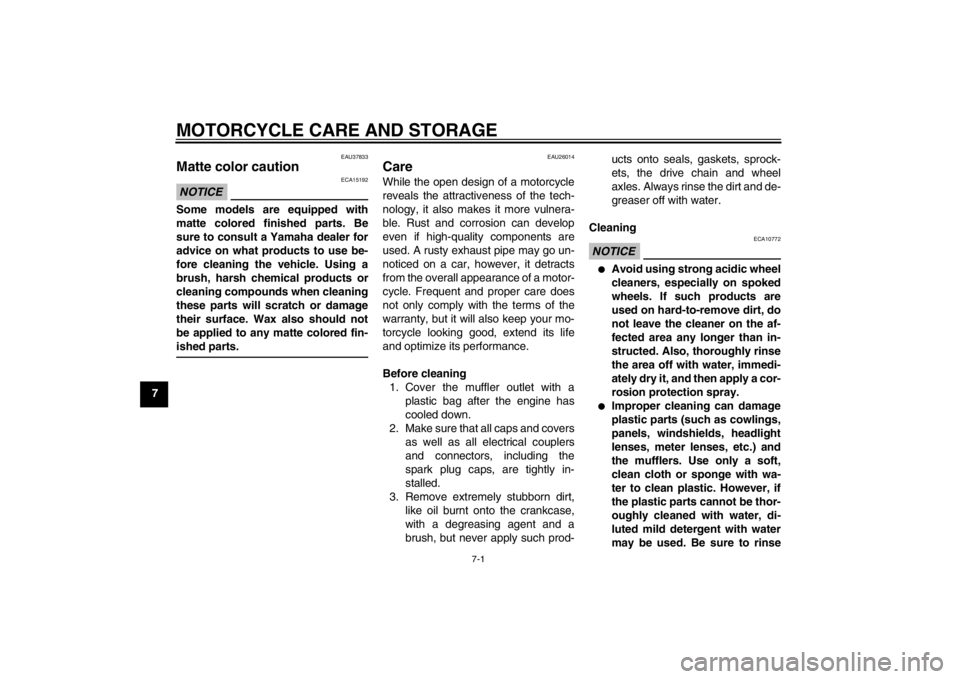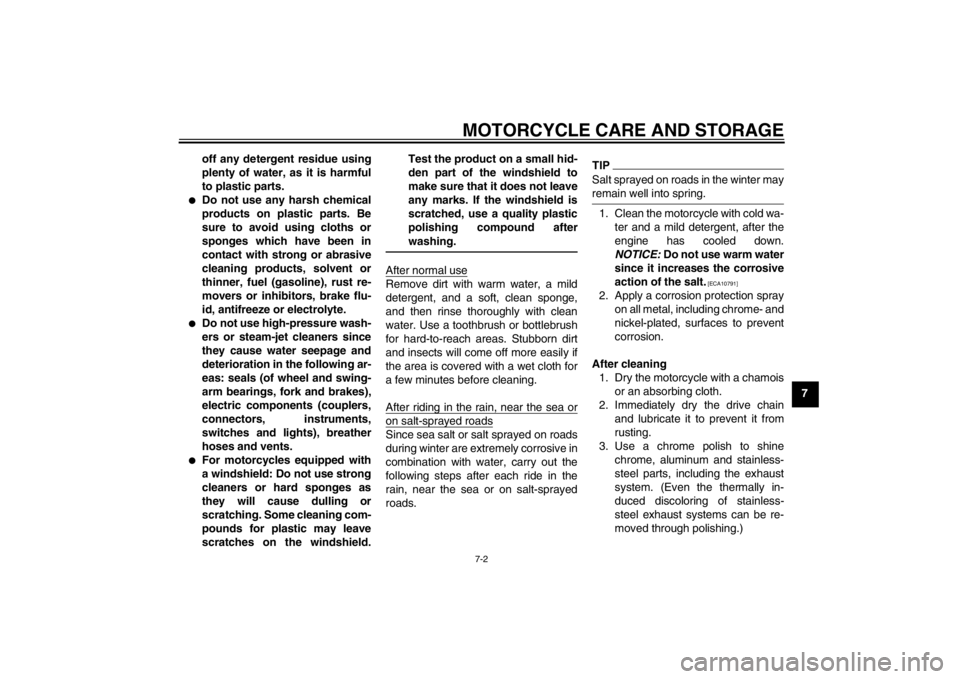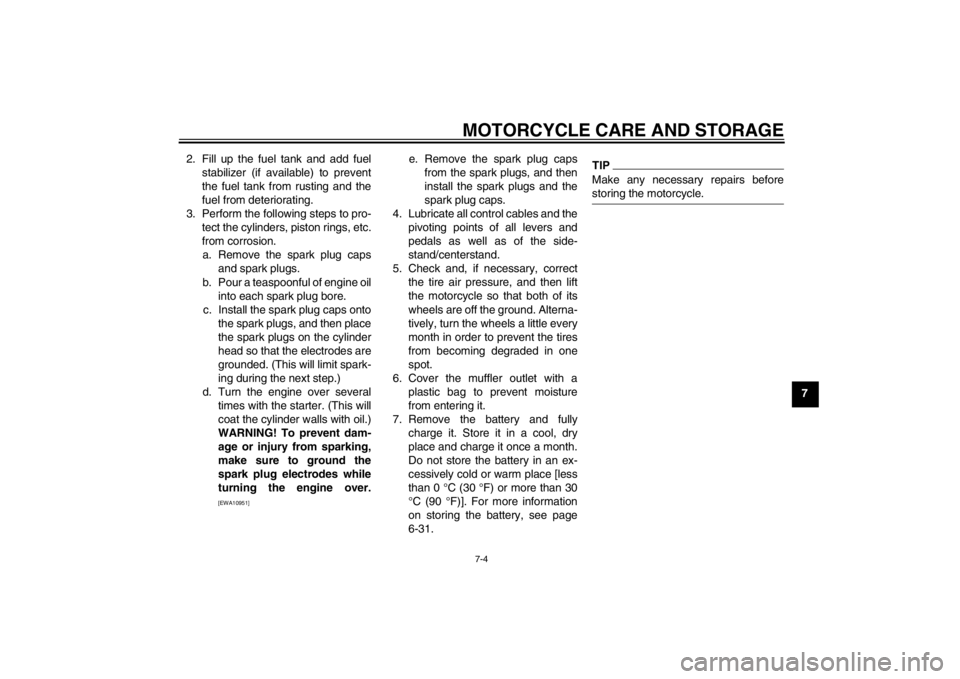2012 YAMAHA FZ1 S wheel
[x] Cancel search: wheelPage 90 of 106

PERIODIC MAINTENANCE AND ADJUSTMENT
6-40
6
●
The drive chain cannot be disas-
sembled.
7. While supporting the brake caliperbracket, pull the wheel axle out,
and then remove the wheel.
NOTICE: Do not apply the brake
after the wheel has been re-
moved together with the brake
disc, otherwise the brake pads
will be forced shut.
[ECA11071]
EAU48402
To install the rear wheel1. Install the wheel and the brake cal- iper bracket by inserting the wheel
axle from the left-hand side.
TIP●
Make sure that the slot in the brake
caliper bracket is fit over the retain-
er on the swingarm.
●
Make sure that there is enough
space between the brake pads be-
fore installing the wheel.
2. Install the drive chain onto the rearsprocket.
3. Install the axle nut.
4. Take the vehicle off the center- stand so that the rear wheel is on
the ground, and then put the side-
stand down.
5. Adjust the drive chain slack. (See page 6-25.) 6. Tighten the axle nut, and then
tighten the locknuts to the speci-
fied torques.
1. Wheel axle
1. Slot
2. Retainer
Tightening torques:Axle nut:150 Nm (15 m·kgf, 108 ft·lbf)
Locknut:
16 Nm (1.6 m·kgf, 12 ft·lbf)
U1CAE1E0.book Page 40 Tuesday, September 13, 2011 5:02 PM
Page 94 of 106

MOTORCYCLE CARE AND STORAGE
7-1
7
EAU37833
Matte color caution NOTICE
ECA15192
Some models are equipped with
matte colored finished parts. Be
sure to consult a Yamaha dealer for
advice on what products to use be-
fore cleaning the vehicle. Using a
brush, harsh chemical products or
cleaning compounds when cleaning
these parts will scratch or damage
their surface. Wax also should not
be applied to any matte colored fin-
ished parts.
EAU26014
Care While the open design of a motorcycle
reveals the attractiveness of the tech-
nology, it also makes it more vulnera-
ble. Rust and corrosion can develop
even if high-quality components are
used. A rusty exhaust pipe may go un-
noticed on a car, however, it detracts
from the overall appearance of a motor-
cycle. Frequent and proper care does
not only comply with the terms of the
warranty, but it will also keep your mo-
torcycle looking good, extend its life
and optimize its performance.
Before cleaning1. Cover the muffler outlet with a plastic bag after the engine has
cooled down.
2. Make sure that all caps and covers as well as all electrical couplers
and connectors, including the
spark plug caps, are tightly in-
stalled.
3. Remove extremely stubborn dirt, like oil burnt onto the crankcase,
with a degreasing agent and a
brush, but never apply such prod- ucts onto seals, gaskets, sprock-
ets, the drive chain and wheel
axles. Always rinse the dirt and de-
greaser off with water.
Cleaning
NOTICE
ECA10772
●
Avoid using strong acidic wheel
cleaners, especially on spoked
wheels. If such products are
used on hard-to-remove dirt, do
not leave the cleaner on the af-
fected area any longer than in-
structed. Also, thoroughly rinse
the area off with water, immedi-
ately dry it, and then apply a cor-
rosion protection spray.
●
Improper cleaning can damage
plastic parts (such as cowlings,
panels, windshields, headlight
lenses, meter lenses, etc.) and
the mufflers. Use only a soft,
clean cloth or sponge with wa-
ter to clean plastic. However, if
the plastic parts cannot be thor-
oughly cleaned with water, di-
luted mild detergent with water
may be used. Be sure to rinse
U1CAE1E0.book Page 1 Tuesday, September 13, 2011 5:02 PM
Page 95 of 106

MOTORCYCLE CARE AND STORAGE
7-2
7
off any detergent residue using
plenty of water, as it is harmful
to plastic parts.
●
Do not use any harsh chemical
products on plastic parts. Be
sure to avoid using cloths or
sponges which have been in
contact with strong or abrasive
cleaning products, solvent or
thinner, fuel (gasoline), rust re-
movers or inhibitors, brake flu-
id, antifreeze or electrolyte.
●
Do not use high-pressure wash-
ers or steam-jet cleaners since
they cause water seepage and
deterioration in the following ar-
eas: seals (of wheel and swing-
arm bearings, fork and brakes),
electric components (couplers,
connectors, instruments,
switches and lights), breather
hoses and vents.
●
For motorcycles equipped with
a windshield: Do not use strong
cleaners or hard sponges as
they will cause dulling or
scratching. Some cleaning com-
pounds for plastic may leave
scratches on the windshield. Test the product on a small hid-
den part of the windshield to
make sure that it does not leave
any marks. If the windshield is
scratched, use a quality plastic
polishing compound after
washing.
After normal useRemove dirt with warm water, a mild
detergent, and a soft, clean sponge,
and then rinse thoroughly with clean
water. Use a toothbrush or bottlebrush
for hard-to-reach areas. Stubborn dirt
and insects will come off more easily if
the area is covered with a wet cloth for
a few minutes before cleaning.
After riding in the rain, near the sea oron salt-sprayed roadsSince sea salt or salt sprayed on roads
during winter are extremely corrosive in
combination with water, carry out the
following steps after each ride in the
rain, near the sea or on salt-sprayed
roads.
TIPSalt sprayed on roads in the winter may
remain well into spring.1. Clean the motorcycle with cold wa-
ter and a mild detergent, after the
engine has cooled down.
NOTICE: Do not use warm water
since it increases the corrosive
action of the salt.
[ECA10791]
2. Apply a corrosion protection spray on all metal, including chrome- and
nickel-plated, surfaces to prevent
corrosion.
After cleaning 1. Dry the motorcycle with a chamois or an absorbing cloth.
2. Immediately dry the drive chain and lubricate it to prevent it from
rusting.
3. Use a chrome polish to shine chrome, aluminum and stainless-
steel parts, including the exhaust
system. (Even the thermally in-
duced discoloring of stainless-
steel exhaust systems can be re-
moved through polishing.)
U1CAE1E0.book Page 2 Tuesday, September 13, 2011 5:02 PM
Page 97 of 106

MOTORCYCLE CARE AND STORAGE
7-4
7
2. Fill up the fuel tank and add fuel
stabilizer (if available) to prevent
the fuel tank from rusting and the
fuel from deteriorating.
3. Perform the following steps to pro- tect the cylinders, piston rings, etc.
from corrosion.a. Remove the spark plug caps and spark plugs.
b. Pour a teaspoonful of engine oil into each spark plug bore.
c. Install the spark plug caps onto the spark plugs, and then place
the spark plugs on the cylinder
head so that the electrodes are
grounded. (This will limit spark-
ing during the next step.)
d. Turn the engine over several times with the starter. (This will
coat the cylinder walls with oil.)
WARNING! To prevent dam- age or injury from sparking,
make sure to ground the
spark plug electrodes while
turning the engine over.
[EWA10951]
e. Remove the spark plug caps from the spark plugs, and then
install the spark plugs and the
spark plug caps.
4. Lubricate all control cables and the pivoting points of all levers and
pedals as well as of the side-
stand/centerstand.
5. Check and, if necessary, correct the tire air pressure, and then lift
the motorcycle so that both of its
wheels are off the ground. Alterna-
tively, turn the wheels a little every
month in order to prevent the tires
from becoming degraded in one
spot.
6. Cover the muffler outlet with a plastic bag to prevent moisture
from entering it.
7. Remove the battery and fully charge it. Store it in a cool, dry
place and charge it once a month.
Do not store the battery in an ex-
cessively cold or warm place [less
than 0 °C (30 °F) or more than 30
°C (90 °F)]. For more information
on storing the battery, see page
6-31.
TIPMake any necessary repairs before
storing the motorcycle.
U1CAE1E0.book Page 4 Tuesday, September 13, 2011 5:02 PM
Page 98 of 106

SPECIFICATIONS
8-1
8
Dimensions:Overall length:2140 mm (84.3 in)
Overall width:
770 mm (30.3 in)
Overall height: 1205 mm (47.4 in)
Seat height: 815 mm (32.1 in)
Wheelbase:
1460 mm (57.5 in)
Ground clearance: 135 mm (5.31 in)
Minimum turning radius: 3000 mm (118.1 in)Weight:Curb weight:FZ1-S 220 kg (485 lb)
FZ1-SA 226 kg (498 lb)Engine:Engine type:Liquid cooled 4-stroke, DOHC
Cylinder arrangement:
Inline 4-cylinder
Displacement: 998 cm³
Bore × stroke:
77.0 × 53.6 mm (3.03 × 2.11 in)
Compression ratio:
11.50 : 1
Starting system: Electric starter
Lubrication system: Wet sump
Engine oil:Recommended brand:YAMALUBE
Type:
SAE 10W-30, 10W-40, 10W-50, 15W-40,
20W-40 or 20W-50
Recommended engine oil grade: API service SG type or higher, JASO
standard MA
Engine oil quantity:
Without oil filter cartridge replacement: 2.90 L (3.07 US qt, 2.55 Imp.qt)
With oil filter cartridge replacement:
3.10 L (3.28 US qt, 2.73 Imp.qt)Cooling system:Coolant reservoir capacity (up to the
maximum level mark):0.25 L (0.26 US qt, 0.22 Imp.qt)
Radiator capacity (including all routes): 2.25 L (2.38 US qt, 1.98 Imp.qt)Air filter:Air filter element:Oil-coated paper element
Fuel:Recommended fuel:Regular unleaded gasoline only
Fuel tank capacity:
18.0 L (4.76 US gal, 3.96 Imp.gal)
Fuel reserve amount: 3.4 L (0.90 US gal, 0.75 Imp.gal)Fuel injection:Throttle body:
ID mark: 2D11 20Spark plug(s):Manufacturer/model:NGK/CR9E
Spark plug gap: 0.7–0.8 mm (0.028–0.031 in)Clutch:Clutch type:Wet, multiple-discTransmission:Primary reduction ratio:
1.512 (65/43)
Final drive: Chain
Secondary reduction ratio: 2.647 (45/17)
Transmission type:
Constant mesh 6-speed
Operation: Left foot operation
Gear ratio: 1st: 2.533 (38/15)
–20 –10 0 1020 30 40 50 �C
10 30 50 70 90 110
0 130 �F
SAE 10W-30
SAE 15W-40SAE 20W-40SAE 20W-50
SAE 10W-40SAE 10W-50
U1CAE1E0.book Page 1 Tuesday, September 13, 2011 5:02 PM
Page 99 of 106

SPECIFICATIONS
8-2
8
2nd:2.063 (33/16)
3rd: 1.762 (37/21)
4th:
1.522 (35/23)
5th: 1.350 (27/20)
6th: 1.208 (29/24)
Chassis:Frame type:Diamond
Caster angle: 25.00 °
Trail:
109 mm (4.3 in)Front tire:Type:Tubeless
Size:
120/70 ZR17M/C (58W)
Manufacturer/model: DUNLOP/D221FARear tire:Type:
Tubeless
Size: 190/50 ZR17M/C (73W)
Manufacturer/model: DUNLOP/D221G
Loading:Maximum load: FZ1-S 190 kg (419 lb)
FZ1-SA 184 kg (406 lb)
(Total weight of rider, passenger, cargo and
accessories)Tire air pressure (measured on cold
tires):Loading condition:0–90 kg (0–198 lb)
Front:
250 kPa (2.50 kgf/cm², 36 psi)
Rear: 290 kPa (2.90 kgf/cm², 42 psi)
Loading condition: FZ1-S 90–190 kg (198–419 lb)
FZ1-SA 90–184 kg (198–406 lb)
Front:250 kPa (2.50 kgf/cm², 36 psi)
Rear:
290 kPa (2.90 kgf/cm², 42 psi)
High-speed riding: Front:
250 kPa (2.50 kgf/cm², 36 psi)
Rear: 290 kPa (2.90 kgf/cm², 42 psi)Front wheel:Wheel type:
Cast wheel
Rim size: 17M/C x MT3.50Rear wheel:Wheel type:
Cast wheel Rim size:
17M/C x MT6.00
Front brake:Type:
Dual disc brake
Operation: Right hand operation
Specified brake fluid: DOT 4Rear brake:Type:Single disc brake
Operation: Right foot operation
Specified brake fluid:
DOT 4Front suspension:Type:Telescopic fork
Spring/shock absorber type:
Coil spring/oil damper
Wheel travel: 130.0 mm (5.12 in)Rear suspension:Type:
Swingarm (link suspension)
Spring/shock absorber type: Coil spring/gas-oil damper
Wheel travel: 130.0 mm (5.12 in)Electrical system:Ignition system:TCI
U1CAE1E0.book Page 2 Tuesday, September 13, 2011 5:02 PM
Page 103 of 106

INDEX
Throttle grip and cable, checking and lubricating ..................... 6-27
Throttle grip free play, checking ........... 6-17
Tires...................................................... 6-18
Tool kit .................................................... 6-2
Troubleshooting .................................... 6-41
Troubleshooting charts ......................... 6-42
Turn signal indicator lights ...................... 3-4
Turn signal light bulb, replacing ............ 6-36
Turn signal switch ................................. 3-13VValve clearance .................................... 6-18
Vehicle identification number.................. 9-1WWheel bearings, checking .................... 6-31
Wheel, front (for non-ABS models)....... 6-38
Wheel, rear (for non-ABS models) ....... 6-39
Wheels.................................................. 6-20
U1CAE1E0.book Page 2 Tuesday, September 13, 2011 5:02 PM